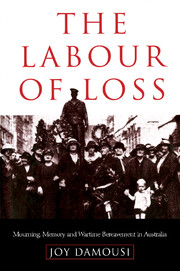Book contents
- Frontmatter
- Contents
- Abbreviations
- Acknowledgements
- Introduction
- Part I The First World War
- 1 Theatres of Grief, Theatres of Loss
- 2 The Sacrificial Mother
- 3 A Father's Loss
- 4 The War Widow and the Cost of Memory
- 5 Returned Limbless Soldiers: Identity through Loss
- Part II The Second World War
- Conclusion
- Notes
- Bibliography
- Index
5 - Returned Limbless Soldiers: Identity through Loss
Published online by Cambridge University Press: 06 July 2010
- Frontmatter
- Contents
- Abbreviations
- Acknowledgements
- Introduction
- Part I The First World War
- 1 Theatres of Grief, Theatres of Loss
- 2 The Sacrificial Mother
- 3 A Father's Loss
- 4 The War Widow and the Cost of Memory
- 5 Returned Limbless Soldiers: Identity through Loss
- Part II The Second World War
- Conclusion
- Notes
- Bibliography
- Index
Summary
to see our brave soldiers boys back from the war wounded and maimed for life … [who] have to be cared for. But they are a cheerful lot of fellows mostly and they will tell you they think themselves lucky if they only lost a leg or arm we think a lot of our Australian boys …
Writing to his mother in 1916, Lance-Corporal Hislop described how he came to have his hand amputated:
[My] left hand [was] so badly shattered that the doctors had to amputate it a little below the wrist. This was only as a last resource as they tried to save part of the hand but failed. You must not let this worry you at all as there are other cases here where men have had to have both legs amputated so I do not complain.
The comparison Hislop drew with other disabled men who were worse off was a common device by which disabled soldiers denned a sense of identity based on dieir distinctive loss, a physical absence which, unlike psychological loss, could not be repressed.
Physically, the disabled soldier was a disturbing presence in the social and political landscape after the war. Amid the celebrations, the disabled soldier, who had seemingly diminished in size and become distorted in shape, assumed a grotesque presence larger than life, offering an ironic comment on the desperate efforts of those around him to wrestle free of the horror of war. The shattered heroes hovered on the margins, defying easy categorisation.
- Type
- Chapter
- Information
- The Labour of LossMourning, Memory and Wartime Bereavement in Australia, pp. 85 - 102Publisher: Cambridge University PressPrint publication year: 1999
- 1
- Cited by

